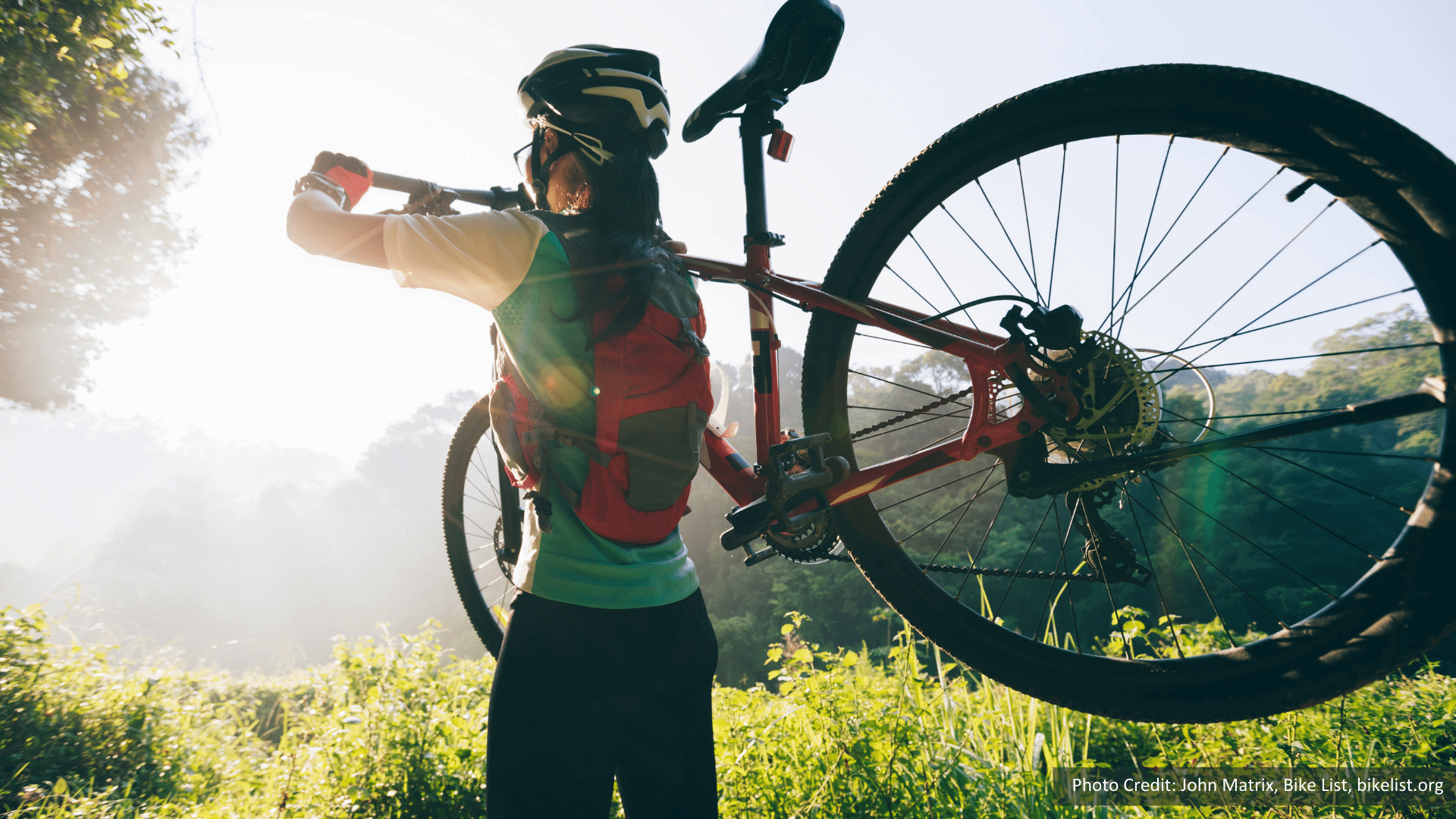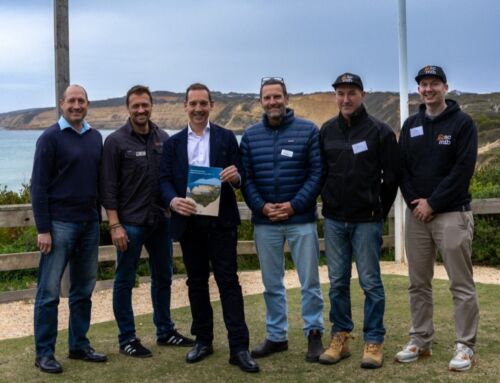WORDS: Chris Ord / IMAGERY: Chris Ord and various sources as credited.
‘Mountain biking’ is no longer just any old ride in any old park. The once-simple recreational pleasure pioneered by a bunch of Californians in the mid-70s is now a complicated web of nuance and nomenclature, one worth millions of dollars to bike manufacturers, trail builders, tourism operators and riders who keep re-inventing the ‘mountain biking’ wheel.
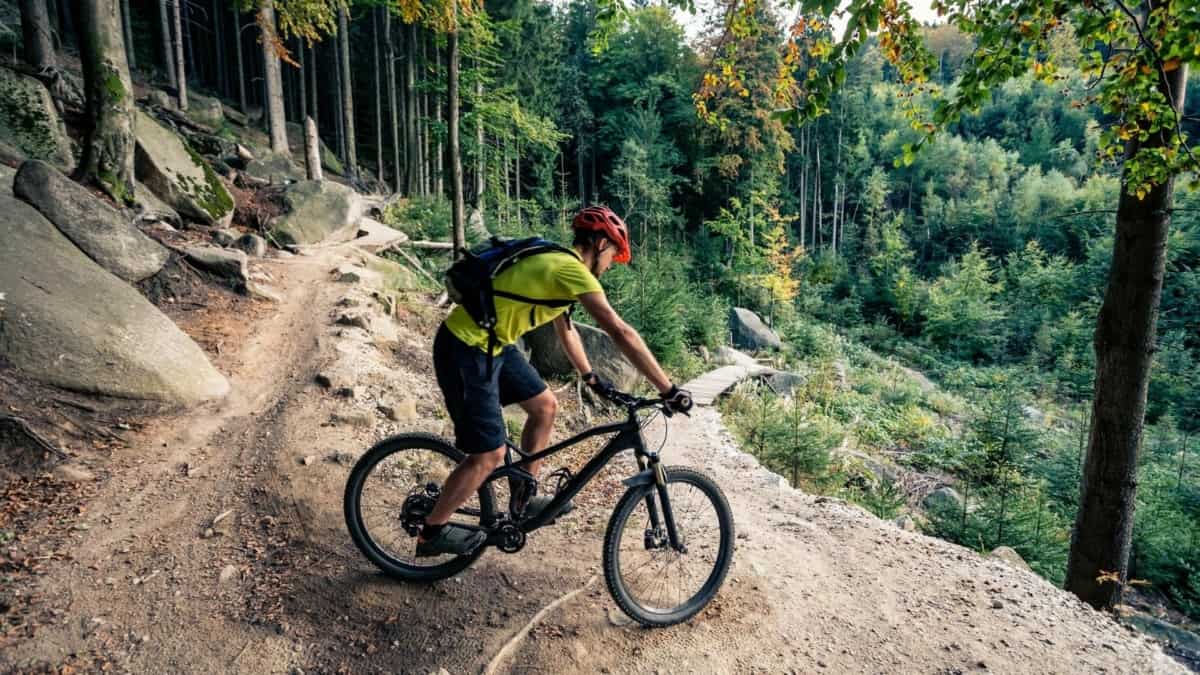
Photo Credit: Canva
Mountain biking used to be a relatively simple concept: grab a bike, find a mountain, ride it. In the beginning, that meant any bike, most often ‘old’ and in the pioneering days, often so-called ‘Klunkers’ – regular town bikes modified and rebuilt; fat tyre Frankenstein flyers, if you will.
But mountain biking has come a long way since Charlie Kelly, Joe Breeze, Gary Fisher and the other gaggle of Godfathers (and Godmother, Wende Cragg) of mountain biking shuttled down Mount Tamalpais, in Marin County, California. After nearly fifty years of evolution, the straight forward idea of riding rough is now more complicated than taming the off-camber corners on Repack, the original and notably tricky to ride trail in Marin County, host to the first-ever mountain bike race back in ’76.
The progression of mountain bike technology has also been phenomenal over the past three decades. From early beginnings where mountain bikes were simply a road bike built with bigger tyres and a hardier frame, to today’s high-tech, highly-specialised bikes that can cost as much as a small car. Today’s mountain bikes feature much slacker geometry, highly sophisticated suspension and gearing, powerful disc brakes, and a variety of lightweight materials that allow riders to pedal extremely efficiently while still being able to tackle rough terrain.
Development of the trails being ridden has also evolved rapidly, with purpose-built networks of singletrack becoming innovative works of art often professionally built and sometimes worth upwards of $10 million in their construction (the payback being millions more in economic stimulus for regional communities and businesses).
Through a mix of evolution, progression, mad science and massive investment, mountain biking has branched out into many different disciplines and sub-cultures, with niches forming within niches.
What is the difference between All Mountain (AM) and Cross Country (XC)? Enduro and Freeride? Or Trail and Trial? Are classifications applicable to the trail, the bike, or how a rider specifically rides a trail? It’s confusing and even the plethora of trail strategies sitting with budget-burning potential on the desks of council recreation officers across Australia and New Zealand seem to use category labels with some crossover.
As mountain biking has increased in popularity so, too, has the way that participants engage in the activity. There is a clear delineation between competitive and recreational (for leisure) riding, although many riders participate within both contexts. However, there is also a proliferation of labels and definitions applied to the ‘style’ of mountain biking, from the traditional cross country (XC) and Downhill (DH) categories that have endured, to newer-fashion variations inclusive of Flow style, Trail (as differentiated from Trial), Gravity Enduro, All Mountain, Freeride, 4X, Cyclo-Cross, Gravel Grind, Backcountry and Adventure Cycling. And there are others…
It’s no surprise, then, that bike manufacturers and brands have tailored products to target different markets and sub-cultures within the ever-expanding mountain biking spectrum. Trail designers and builders have also tailored how trails are built to offer specific experiences relevant to the various styles of riding.
Regions looking to attract and facilitate the mountain biking community need to be mindful of the increasingly diverse nature of what ‘mountain biking’ actually is or is perceived to be by different markets. Curators of mountain biking also need to recognise that riders today demand a higher quality of experience and service across what is an increasingly fragmented market profile. The challenge for mountain biking regions is to target the biggest user base that best matches the style of riding best suited to the landscapes available.
A study of different mountain biking categories quickly becomes a study of fragmentation. We list 19 categories here with plenty of crossover between them. We’ve defined ‘mountain biking’ as any style of cycling that travels off bitumen seeking an experience enjoyed in nature and on two wheels. Yes, we drew the line at unicycles and tricycles. You want to take them bush? Be our guest, we doubt there will be much of a line behind you, unlike those listed below.
Welcome to the mountain biking category masterclass, where every rider has one thing in common: talking dirty.
Here’s what’s covered:
- Cross Country (XC, inclusive Olympic and Marathon disciplines)
- Trail
- All Mountain (AM)
- Gravity Enduro
- Downhill (DH)
- Freeride
- Flow
- 4X
- Dual Slalom
- Dirt Jumping / Freestyle / Slopestyle
- Trials
- Cyclo-cross
- Gravel Grind
- Backcountry/ Bikepacking / Dirt Touring
- Adventure Riding
- Fatbiking
- eMTB
- Pump Track
- Single Speed
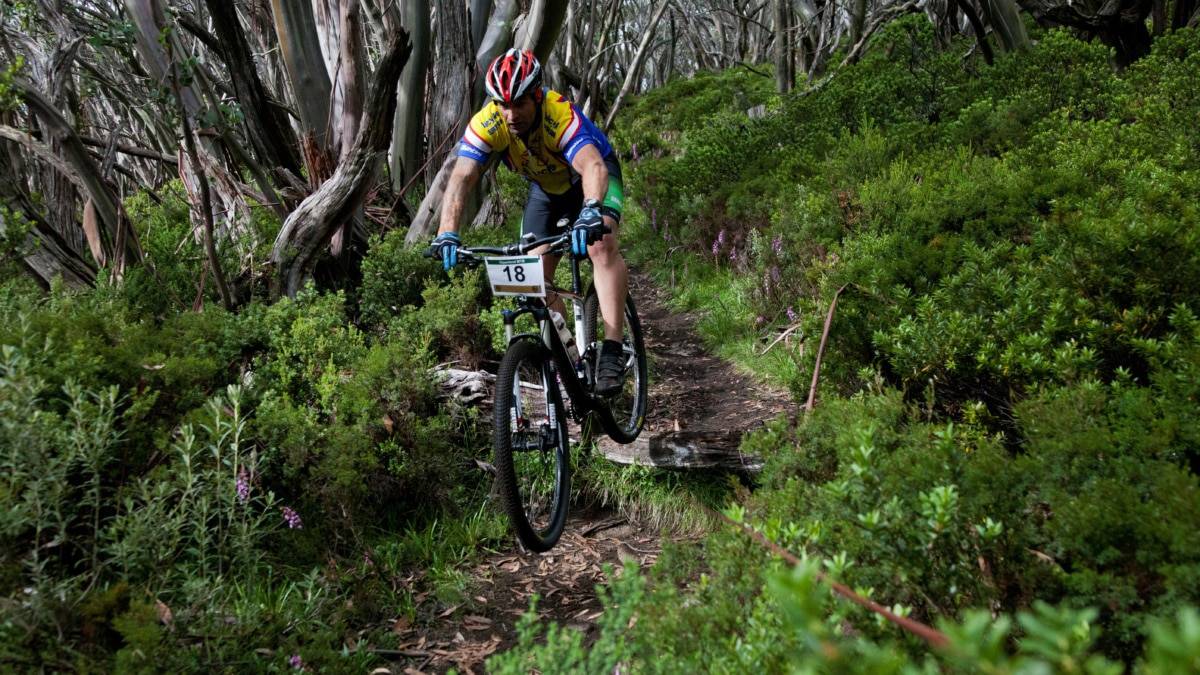
Photo Credit: Chris Ord
CROSS COUNTRY (XC, XCM, XCO)
Considered the foundation category, XC takes place on an assortment of fire access roads, technical forest trails, doubletrack, singletrack, rock gardens and everything in between.
Distances tend to be longer with Cross-Country ‘marathon’ (XCM) a popular format taking in 50km – 100km. In this style, a rider’s capacity for endurance is the primary edge (‘Enduro’ used to be a category label of long distance XC, but the term has since been re-aligned in Australia with downhill-orientated ‘Gravity Enduro’, to match European nomenclature). Riding tends to take in big climbs and heady descents with plenty of undulating terrain in-between, so riders have to work harder, pedalling for extended periods.
Trails tend to be raw in terms of any ‘build’, demanding an all-round ability to manoeuvre a bike with plenty of technical skill over natural features such as logs, rocks, roots, and small drops. Trails are not, in general, overly manicured.
XC is the style of mountain biking represented in the Olympics. Referred to as XCO, courses are looped, rather than purely point-to-point ‘across country’ but trend toward similar distances and terrain mix.
XC bikes usually have a rigid or partly rigid lightweight frame (aluminium, carbon, titanium) and are designed for sharp handling with usually short-travel lockable front suspension of around 100-120 mm. While XC bikes can come with full suspension, they are traditionally less popular (in this category) because of added weight, although that has changed in recent years as bike technology and lightweight materials have advanced. Frame geometry works to optimise pedalling and in particular climbing, so riders are less upright than on a DH bike with the seat normally level with, or slightly higher than handlebars. With a push to make XCO courses more challenging, dropper seat posts are starting to appear on the XC scene.
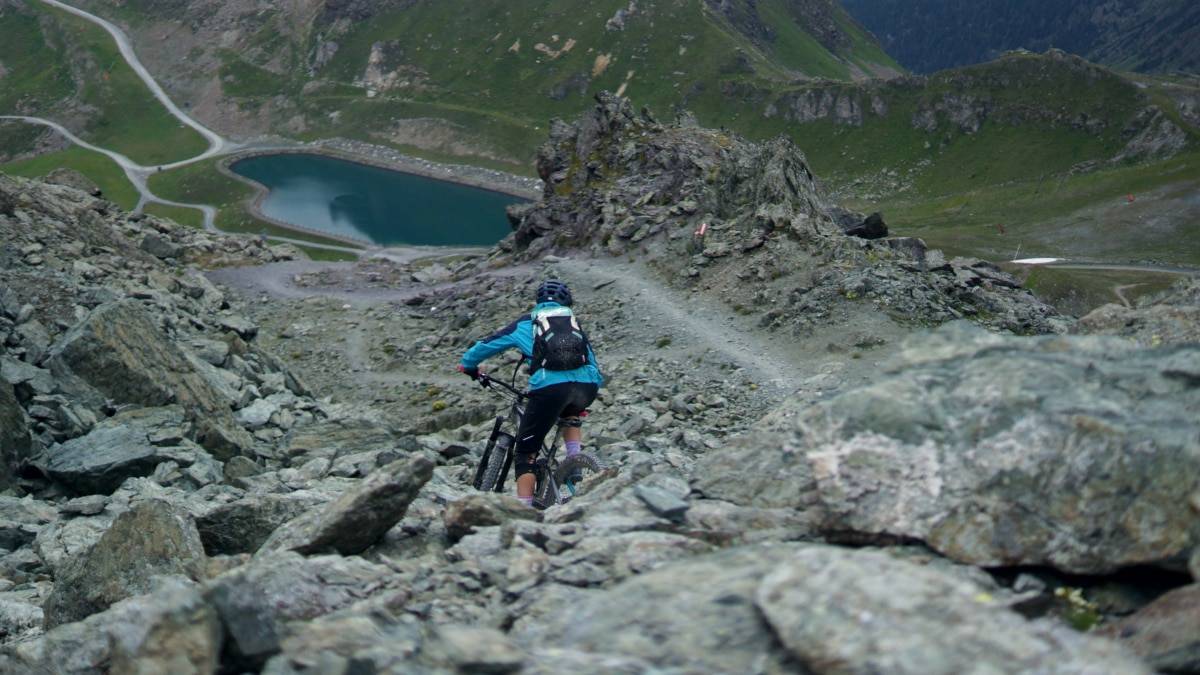
Photo Credit: Unsplash
TRAIL
‘Trail’ riders lean more towards the adventurous side of things, their style being very much of the all-rounder category (NB: the label ‘Trail’ as a ride style or label is not often used in Australia/New Zealand, it being more of a Northern American categorisation).
These folks often prefer recreation to competition and may only compete once a year or less. Trail riders are the ‘long boarders’ of the mountain biking world (apparently beer is a key part of the experience).
Trail riding is in many ways an echo of Cross Country, however riders in this style look for bigger features and obstacles and are less bound by the XCO and XCM athletic endeavour. Long climbs are part and parcel, just as in XC, but there is a bigger emphasis on chasing descents to get the adrenaline pumping with jumps, drops, rock gardens and berms. You could say that it’s XC with the technicality and fun factor dialled up and the effort factor somewhat softened.
Trail riders take on a wide range of singletrack (and other types of track) but always have an eye out for black diamond-type trails in the mix. They seek a mix of fast and flowy along with more technically challenging trails. Trail riders are more likely to be logging on to Strava to check a segment title and checking in with mates to see who had the guts to take on the biggest drop off. They are not generally concerned with uphill speed. Getting to the top is just a down payment for the fun of the riding back down.
Bike set up favours dual suspension, (although hardtails are still part and parcel), but with an emphasis on still being as lightweight as possible (you still have to pedal up, remember), and with more travel on the front forks of 120mm- 150mm to cope with the more technical descents and drop offs.
In Australia and New Zealand, ‘Trail’ style would perhaps be shuffled under the umbrella of the next category – All Mountain.
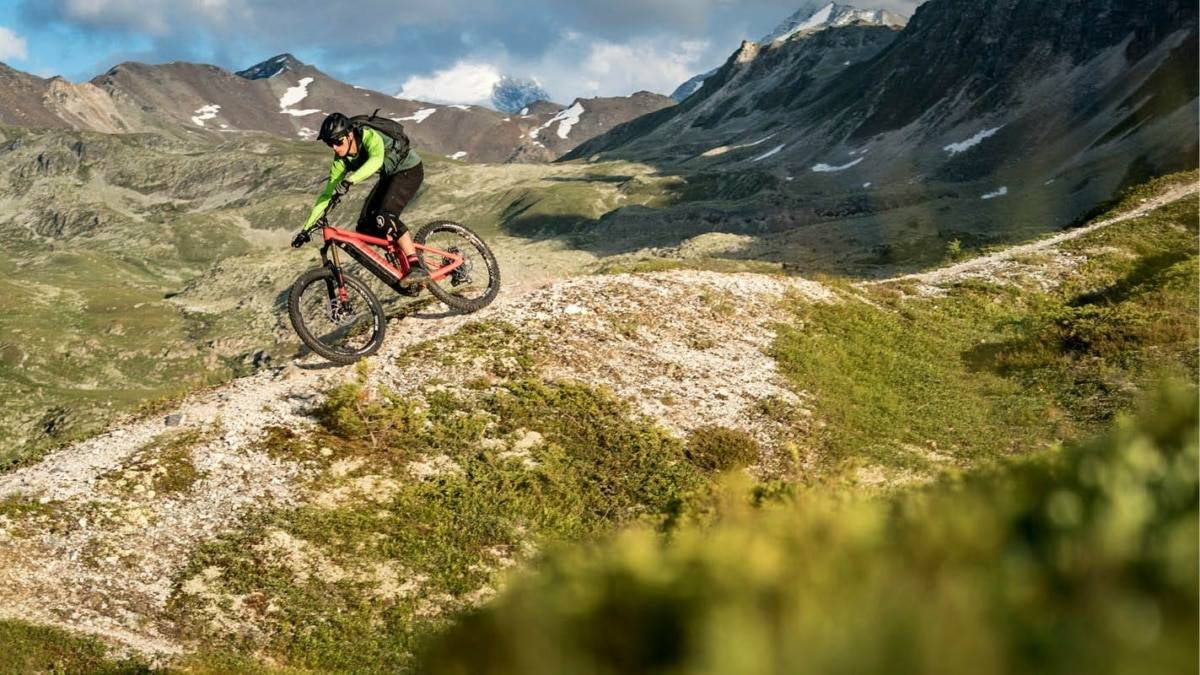
Photo Credit: BMC
ALL MOUNTAIN (AM)
Take a dash of XC, mix liberally with plenty of downhill-style bombing descents, and you have All Mountain. Though similar in some respects to XC and indeed Trail, in that there is both up and downhill segments, these bikes are perhaps geared towards performing best on downhill and more technically complicated terrain. In which case riders need a more versatile MTB, with perhaps less competitive edge than XC bikes but more aggressive than the trail models as far as steering angle. In this category, we mostly find full suspension bikes with greater suspension travel (between 110 and 140 mm) and 29” wheels (for getting over those bigger obstacles).
All Mountain biking involves more varied terrain and challenging obstacles. Essentially, it involves riding through the mountain’s natural topography. While some marginally manicured trails may be present to guide bikers, they aren’t easy to manoeuvre by any means – that is, they aren’t ‘Flow’ style trails (we’ll get to those). All Mountain biking takes advantage of the mountain’s natural drops and jumps and is incredibly challenging, requiring great skill, control and a level of fearlessness. A rider’s focus must remain consistently on make repeated jumps through a mountain’s landscape.
In some ways, All Mountain sits somewhere between XC and DH, and a notch up the extreme-o-meter from Trail, with blurred boundaries between each. Good AM bikes can be ridden on dedicated DH trails although you won’t be going quite as large as you would with a dedicated DH bike.
All mountain bikes are normally heavier and more robust than XC bikes in order to handle the tougher trails. Typically, they have full suspension with travel of 140-160 mm. Frame geometry is somewhere between that of the XC and DH bikes in order to provide more control when descending but still be able to adequately ride uphill under pedal power.
Are you thinking “All Mountain sounds very much like Enduro…”? Well, yes, but…
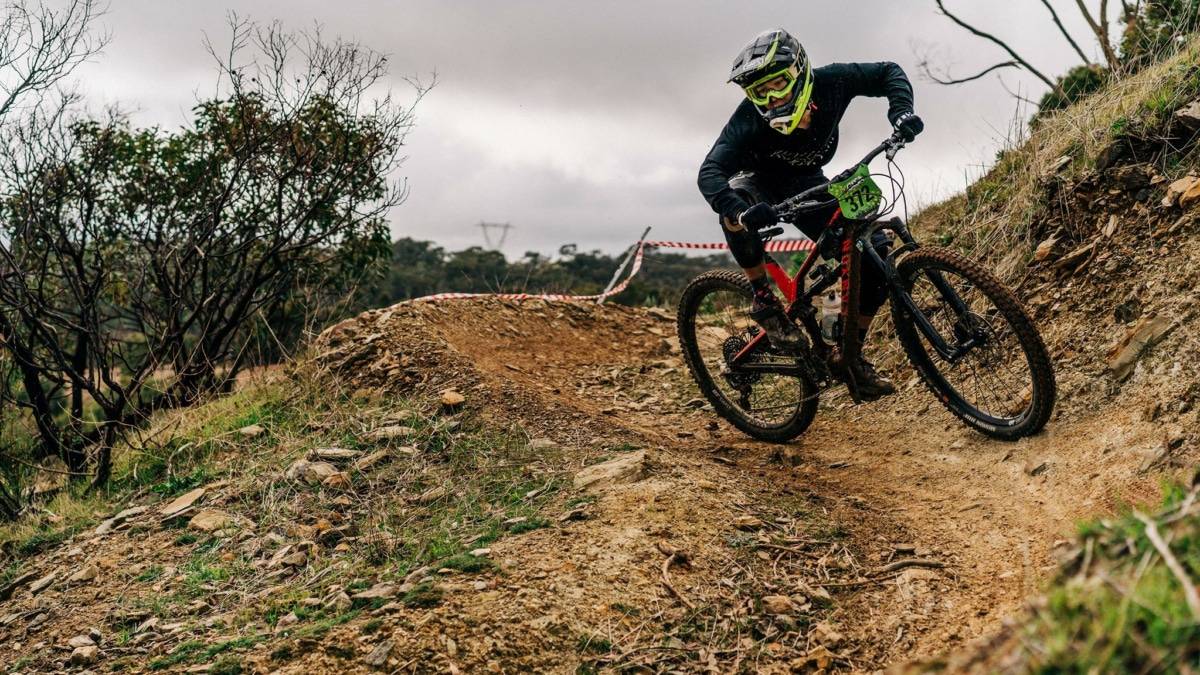
Photo Credit: Gravity Enduro South Australia
GRAVITY ENDURO
Gravity Enduro is a more competitive type of mountain biking that combines elements of DH, XC and AM. Riders take on uphills – usually at their own pace – in order to attack timed downhill sections. Gravity Enduro mountain biking has been a bit of a growth discipline in Australia, sparked by popularity in Europe where the category sparked in France in the early 2000s.
Interestingly, while Gravity Enduro is the “new kid on the block” it does hark back to the origins of mountain biking where you had to pedal to the top to earn your turns and bomb downhill with your mates. The nature of Gravity races also makes it more sociable that other competition formats, adding to its popularity. Furthermore, many amateur and pro DH riders are moving across to Gravity Enduro as they get older because it is easier on the body and better for fitness.
As with All Mountain, bikes used in this category have genetic coding from all of XC, Trail, AM and DH, but essentially these bikes are mainly designed for going downhill, including technical descents and very fast sections. You still have to make it uphill by your own means while saving energy, the idea being to complete several downhill stages in each race – but it’s only the downhill segments that matter to timing. Courses are usually around 30-50km with timed sections split around the often looped course. ‘Clover leaf’ multi-loop courses are common, too, and in networks with limited climbing options participants may be required to climb the same uphill more than once to loop into other stages.
Essentially, Enduro is a competitive and more extreme format of All Mountain. Given the timing of the uphill doesn’t matter, these bikes are not as efficient climbers as XC or Trail models. Suspension travel usually ranges between 150mm and 170mm and bikes have a more aggressive geometry than XC, Trail or AM. Enduro bikes tend to combine the low weight of XC bikes with adaptability of AM and the high performance of DH bikes.
Where Gravity Enduro gets more inclusive is in the trails used – often they are not as aggressive or extreme as pure DH, allowing a broader range of rider skill base to tackle them. And while a specific Gravity bike is great, Enduro trails can still be ridden and enjoyed by riders on XC, AM and Trails bikes.
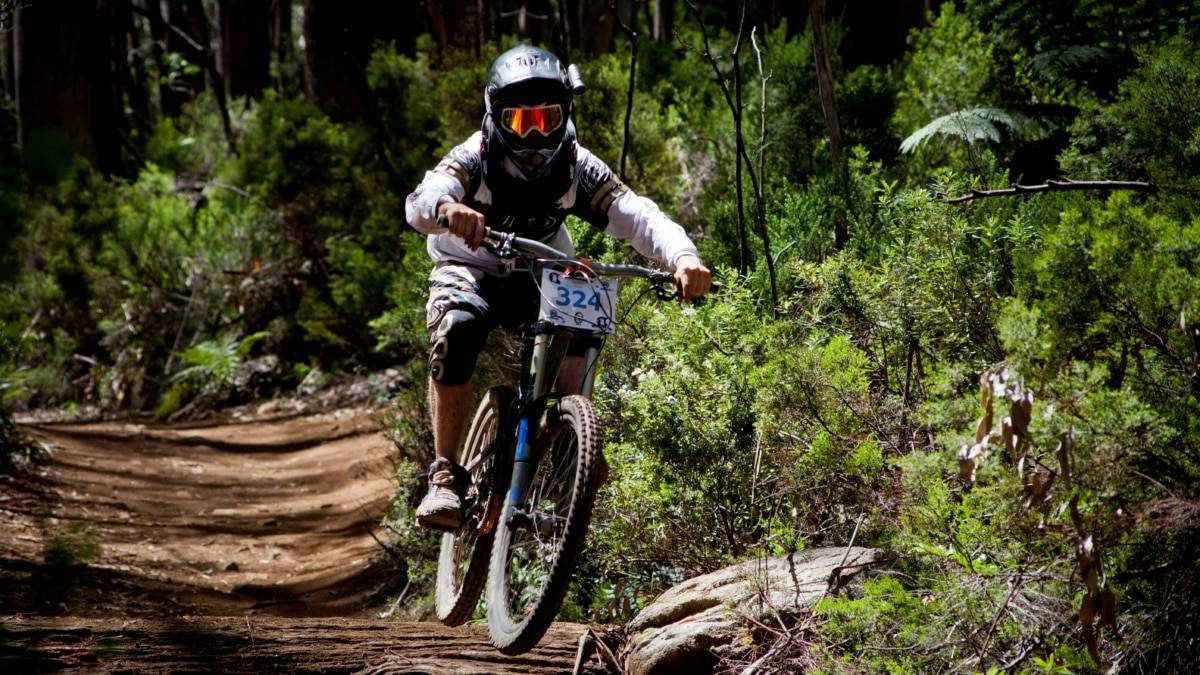
Photo Credit: Chris Ord
DOWNHILL (DH)
Okay, now you can forget riding uphill altogether. Catch the bus or the lift back to the top once your run is done. This extreme version of mountain biking is all about big: big jumps; big airs; big speeds; big adrenaline. And if you mess up, big crashes.
Bike set up, tuning and tailoring the handling for each course is also key on the pro circuit. DH is mountain biking’s equivalent of Formula 1 where bike technology is constantly adapting and every split second counts.
Riding tends to be a on shorter, point-to-point trails that drop off exceedingly steep sides of mountains and feature lots of highly technical obstacles, from huge rock drop offs and long ramp jumps, to massive trees to be dodged at high speed and rock gardens that are hard to walk through let alone ride over.
Because of the short length of trail combined with the extreme athleticism (and bravery) of the riders doing gravity-defying things with bikes, this is the discipline best suited to enjoyment for spectators.
DH bikes are designed to perform very fast and safely on descents, meaning massive dual suspension set ups with 180-220mm fork travel and 29er wheels. This is to enable the huge jumps and technical challenges at high speed, which is the aim of DH – who can get down an impossible to ride section of steep trail the fastest? Focus and control are core along with an absolute lack (or at least control of) of fear.
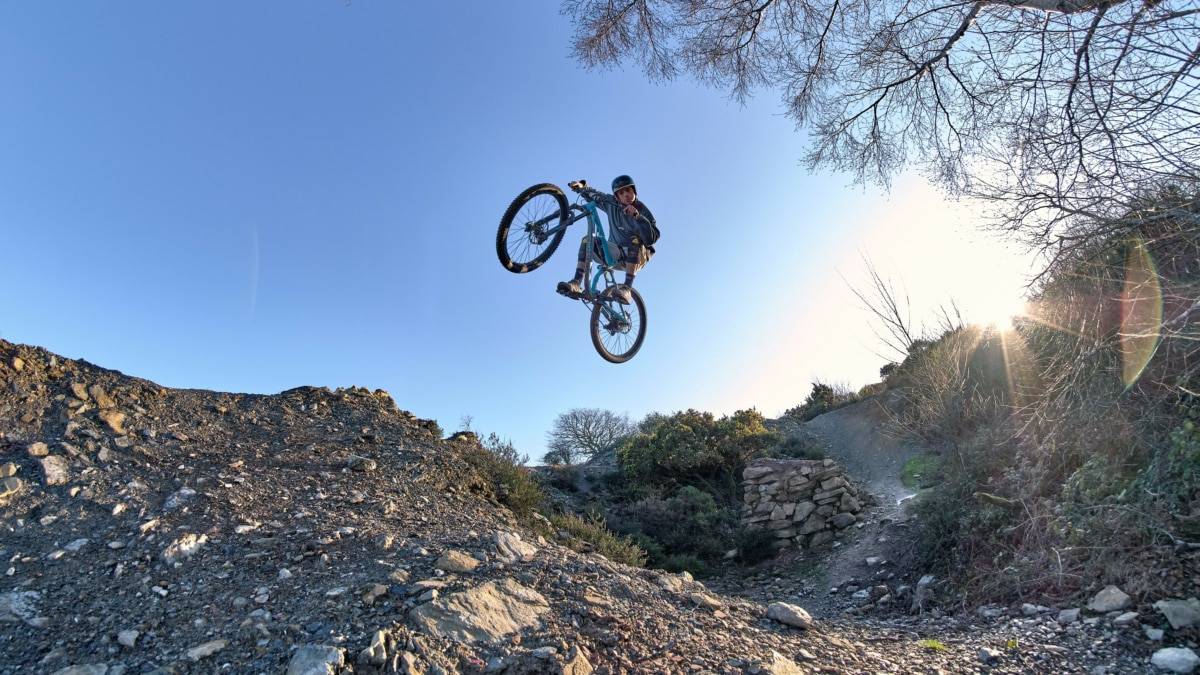
Photo Credit: Unsplash
FREERIDE
This discipline is closely related to Downhill mountain biking with elements of dirt jumping in the mix. It focuses on the art of tricks and sublime bike control as riders tackle natural and built obstacles riding down a mountain. In many ways, it is an artistic incarnation of downhill, where the focus is less on speed and more on the skill of the rider and how they control the bike. Along with DH it is one of the MTB styles and disciplines that gets the most media attention for its sheer audacity. Think Red Bull Rampage videos.
There are no rules or guidelines to follow, rather riders take advantage of the natural terrain and special features built into the trail such as ladders, ramps, and beams, to test their creativity in how to ride and pass over each technical challenge. Freeride mountain biking is a very versatile discipline. Depending on your riding style, you may go for speed to achieve high jumps or control to overcome or master intricate trail features. Either way, most of trails and riding areas incorporate big drops and a number of obstacles.
Because the discipline focuses mainly on tricks and style, bikes are similar in design to bikes made for dirt jumping. They usually have full suspension systems with at least 170mm of suspension travel to absorb the shock of a drop. While they are also mainly made for riding Downhill, they do perform better ascending a trail than Downhill bikes.
To make manoeuvring simpler, these bikes have very light frames. This allows you to go through intricate features of the trail or riding area. They are an agile type of mountain bike that gives you more control and stability, regardless of what trick you are doing.
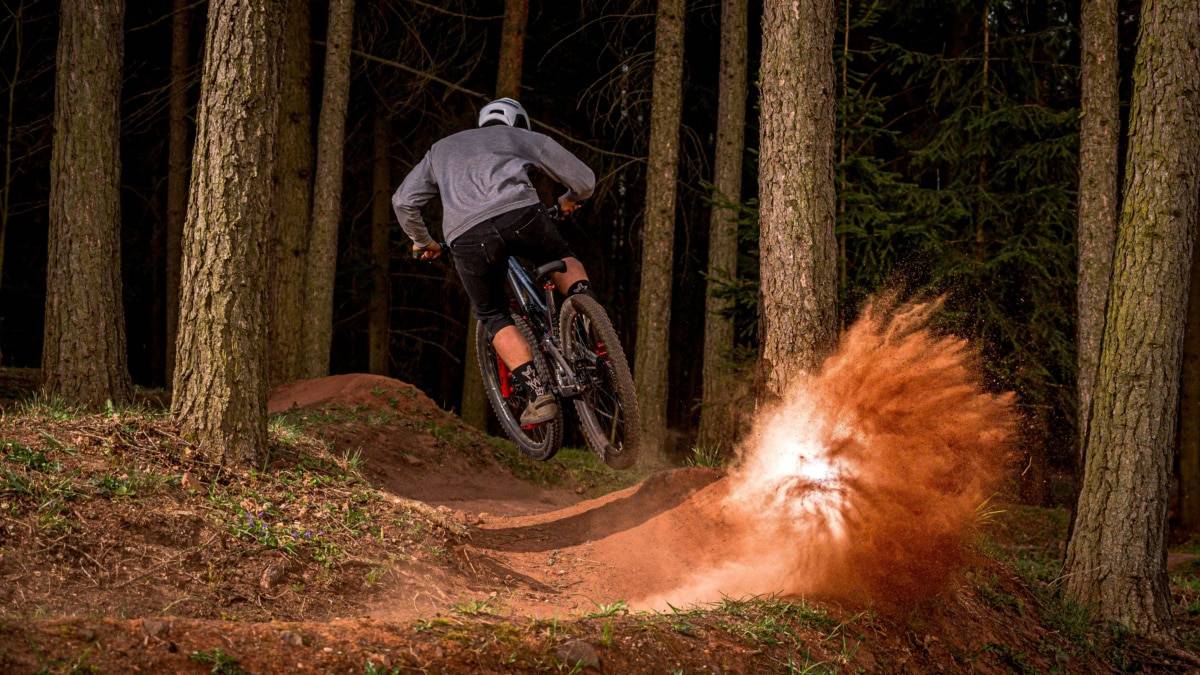
Photo Credit: Unsplash
FLOW
Here we get less into a category of riding defined by the bike and what it is designed to do, and more into how a trail is built and its specific features, which define the ride experience. That is, one of ‘Flow’.
As trail builders have (quickly) advanced their knowledge and skills, they have been able to conjure up trails that extract the most fun for the broadest range of riders. A Flow trail is a trail that allows you to attain a feeling of control at some speed, while flowing over perfectly proportioned and positioned rises and dips (rollers), and around perfectly formed berms that seem to guide the bike without much input (more or less!). It’s ‘easy’ riding in that there are less technical features that require slow, stop, start, bump in, bump out, concentrate-hard-lest-you-go-over-handlebars expertise. Instead, it’s about letting the trail design keep you on track and on the bike while you focus on body position to extract the best speed around, over, and through features and, if you are an advanced rider, the biggest air over an A-line jump so well designed it has you kissing back down with barely a puff of dirt.
Flow trail is also more ‘predictable’ and inclusive. As a generalisation, a rider at any skill level can enjoy it. Mountain bikers can ‘ride blind’ along a trail never seen before, yet ‘trust’ the trail builder and let go of the brakes to maximise fun. Fall hazards are also minimised making injuries less likely. This means these trails are favoured by older riders because of the buzz reward without the risk. Arguably this represents the biggest potential in the mountain biking tourism market, representing a majority of riders who have disposable income and go on regular bike-centric trips.
Usually machine-built and often buff (smooth), Flow trails often use descending landscapes to make the most of gravity but drops are rarely aggressive, rather they ‘flow’ gently down a mountain, weaving back and forth where needed to eke out as much rollercoaster fun as possible for not a huge amount of effort. A good Flow trail will have both pedalling and braking at a minimum with consistent and predictable terrain. Yes, climbing is still part and parcel, but again, trails are built with a gradual climb, where a decent gear set (or an e-Bike) makes it not too much if any out of comfort zone riding. Often, Flow trails will rely on a shuttle bus to return riders to the top, and unlike a DH trail, the point to point distances are much longer for an extended fun factor. No wonder ‘Flow’ trails have quickly become popular.
The nature of Flow trails also means they are easier to maintain – and important consideration for land managers – as they avoid heavy braking and cornering.
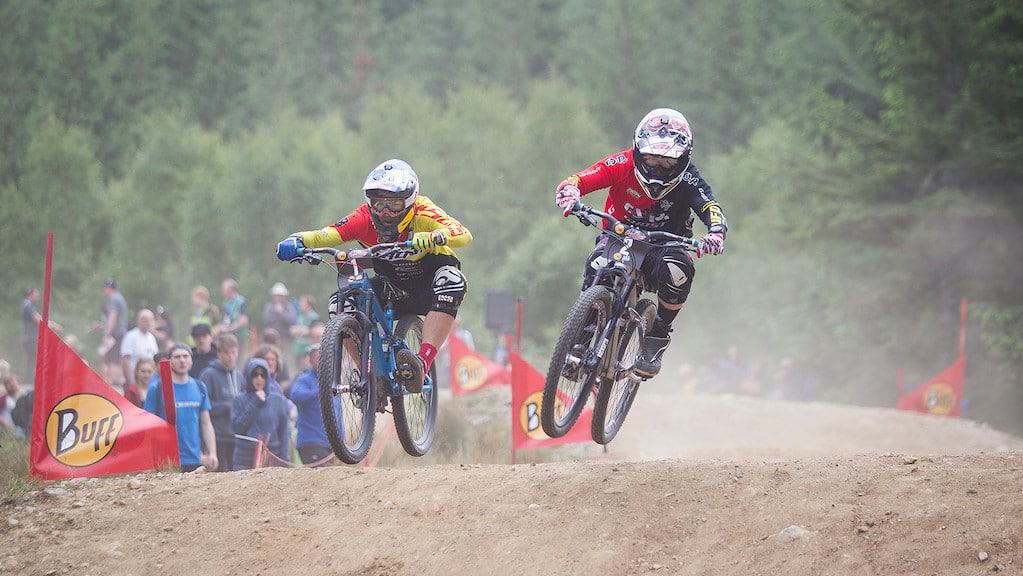
Photo Credit: Felix
4X
Four-cross, also called mountain cross, is fast paced competitive racing with four riders on the same short-distance, loop track. Some may see this as BMX on steroids given the courses look similar at first glance. 4X, however, features bigger (mountain) bikes, bigger jumps, more berms, and less competitor riders at the start gate (four as opposed to BMX having up to eight).
The aim of traditional (competitive) 4X, as with BMX, is to be first past the finish post. 4X riders use very similar bikes to dual slalom, usually full suspension, although some opt for hardtail to get a better ‘kick’ out of the start gate and more speed through berms.
While 4X germinated from a competitive seed, the accessibility and relative ease of building tracks that need only a small footprint – meaning they can be placed within or nearby residential areas – means 4X tracks have become popular with recreational riders seeking a bit of fun or to improve their bike handling skills.
Tracks are highly groomed and designed specifically for flow, speed and jumps. There are generally no ‘technical’ features in terms of drops, rocks, logs or other obstacles found on more traditional MTB trails such as XC. Another way to think of 4X is as mini-flow trails contained within a small park.
The ability to ride 4X trails no matter your skill level has seen them become popular with kids and families learning to mountain bike and are they now seen as an important skills progression pathway and thus an integral part of the mountain biking facility jigsaw.
Popularity of 4X as a competitive format has declined in recent years as it is no longer promoted by the competitive governing body, UCI, owing to venue provision being expensive with high environmental impacts. Community-based, 4X-style tracks and venues continue to be popular, however, serving as much-needed skills progression facilities located within communities or at popular trail heads.
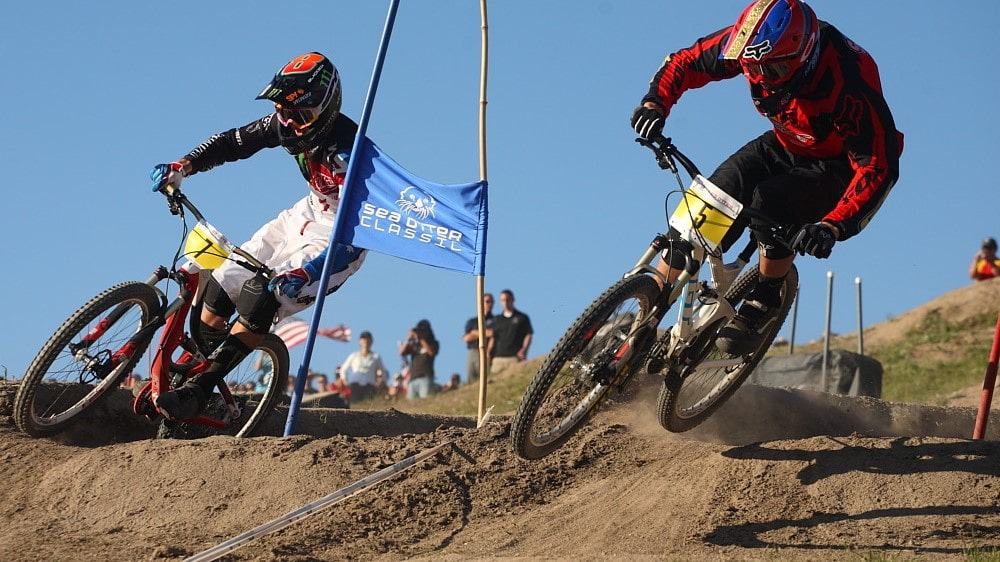
Photo Credit: Sea Otter Classic Dual Slalom Event
DUAL SLALOM
A discipline not heralded much Down Under, and with origins in California, Dual Slalom is a format that sees two riders race head to head, using a BMX-style start gate, down heavily engineered and manicured, open mountainside trails that are set side by side. The dual trails are packed with mostly mirrored berms and jumps and the visual spectacle is very much like slalom skiing, only no snow and on two wheels.
Courses are typically short and the side-by-side, open-view nature combined with fast and furious racing makes it a popular spectator sport. In many ways it is related to 4X racing, albeit with point to point courses set on a steady descents, as opposed to 4X’s undulating loops.
Dual Slalom is a competitive scene, with riders generally getting two ‘runs’ down the track against their opponent, the fastest combined time (each rider taking on both tracks) deciding the winner. They then move through to the next round and competitor in a knockout format. A ‘run’ is usually in the order of 30-45 seconds or so. Dual Slalom is often features as part of a bigger festival where riders compete in a variety of different events and formats.
The focus is on finding every ounce of speed by efficiently navigating the jumps and berms, and finding the best ‘flow’ as they hurtle down the track. Bikes tend towards DH or Gravity Enduro style, dual suspension, and riders wear full face helmets.
Dual Slalom Tracks can be any length so long as they start and finish at the same location, but in general are in the vicinity of 200 metres. Often, they are co-located at bike parks with other facilities (i.e. 4X parks), or within mountain top village precincts for easy access, green season use. Sometimes they are temporary, taking a month to build with earthmoving equipment and/or hand building, with the aim of returning the ride field back to nature once a competition is done.
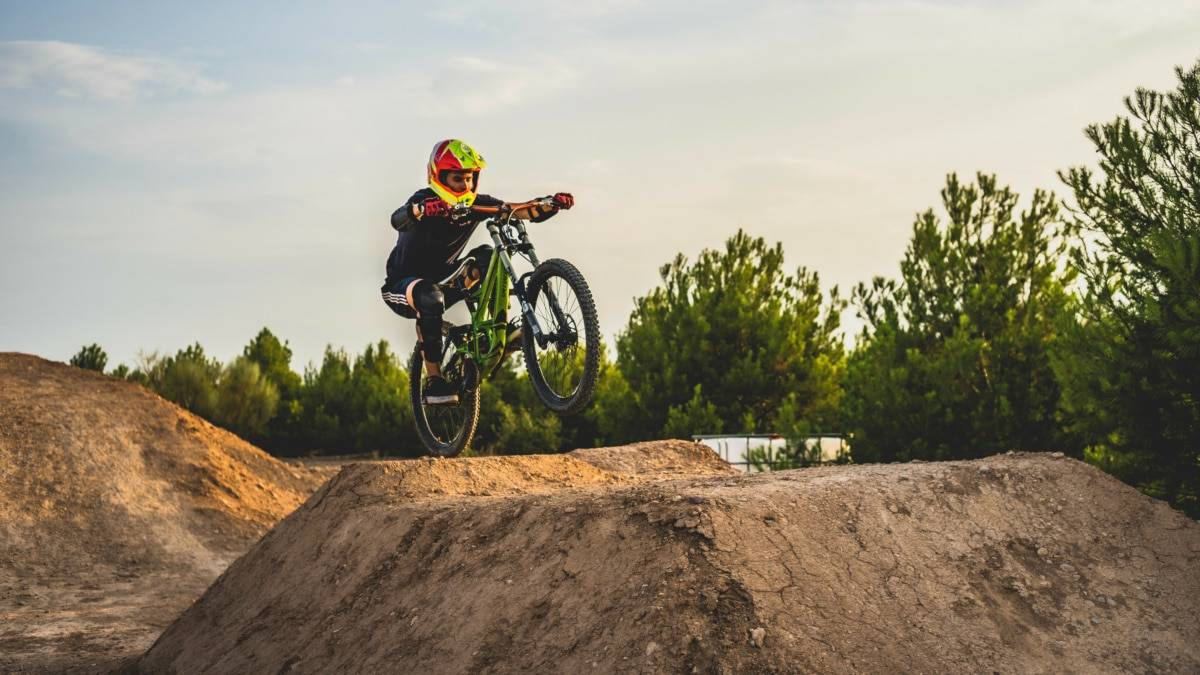
Photo Credit: Unsplash
DIRT JUMPING / FREESTYLE / SLOPESTYLE
As the name implies, this category is entirely focused on getting huge air off tailor-made dirt jumps and the creative aerial manoeuvres that can be executed. Oh – and then nailing the landing. A critical skill in this category.
As with 4X, this style of mountain biking usually takes place in dedicated dirt parks where amateur trail builders take great pride in design creativity. There are usually many different types of jumps set up all in quick succession, with ramps of varying heights and angles providing challenges of approach, launch and landing. Building and maintaining the jumps is as important as riding them in this group with a “do dig = no ride” understanding in some crews. These ‘dirt sculptures’ also need to be maintained at optimal moisture content for the best results.
Many land managers struggle to cater for this group and as a result dirt jumps are often unsanctioned or built in secluded areas.
The aim is to judge the best speed to perform a variety of tricks mid-air – like a two-wheel gymnast – before landing safely on the other side. It requires strength, control, a knack for acrobatics and a healthy degree of risk-tolerance. Oh, and a capacity for heights, given riders find themselves soaring several stories above ground.
Dirt Jumping bikes tend to be robust but simple in design. They are lightweight and have a sloping design that helps build speed on the approach. Hardtail bikes are common, but full-suspension options exist. Suspension travel is typically less than 100mm, and suspension settings are usually firm to prevent bottoming out while jumping. Often dirt jumping bikes won’t have a front brake at all, as they get in the way of tricks, and single speed gearing is the norm. Bike frames are rigid and built very strong to cope with the pounding of repeated and harsh returns to earth, and the seat is set very low, well out the way for performing tricks. Wheels are also robust as they take a lot of punishment.
In some respects, Dirt Jumping could be considered an extreme and concentrated form of Freeride (which focuses on air and tricks but in a more natural mountain setting and often on downhill slopes). A major difference is that Dirt Jumping is set on closed-circuit trails, and often on relatively flat ground so as to enable the creative build of jumps set in succession.
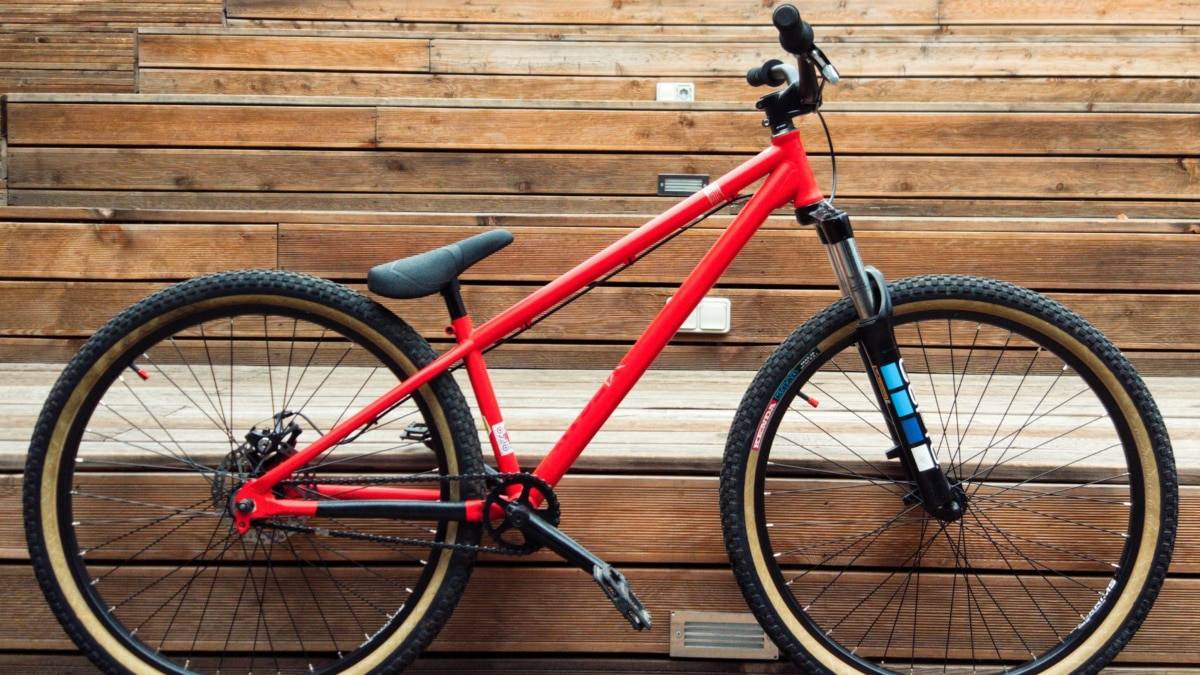
Photo Credit: Unsplash
TRIALS
Ever heard of Danny MacAskill? No? Ok – seen a viral video of a guy doing impossible tricks on a mountain bike with no seat? Ok – so you do know what Trials is (note: Trials, as differentiated from Trails, as a category)!
What you may not know is that it has progressed beyond riders using urban features to challenge their jump, balance and trick skills. These days, 4X parks will sometimes include to one side an area specifically designed, developed and built for Trials riders, with logs and rocks artistically arranged in a ‘trick garden’ of sorts that has to be navigated through. Trials competitions set up obstacle courses where the challenge is to never set foot on the ground.
While many Trials parks are custom built, trials riders also like to see what nature has to offer in terms of challenges, and they do seek out rock garden-style patches in the natural environment and/or working random urban concrete obstacles.
The core skill in Trails is an extreme sense of balance and precision, along with a sense of artistry in how to move around a set of random or curated obstacles. It’s like ballet on two wheels. Unlike dirt jumping or 4X where the action is fairly fast-paced, Trials riders move with more considered intention between tricks, carefully setting themselves up to execute the next move. While the visual spectacle will have your heart pumping with adrenaline (will they nail that big bunny hop between two ten-foot-high rock ledges?), the rider will be ice cool calm.
As with dirt jumping bikes, seats on Trials bikes are low or gone altogether, as riders are always standing ready for a trick manoeuvre, and frames and wheels are built tough to withstand big crunches off high drops.
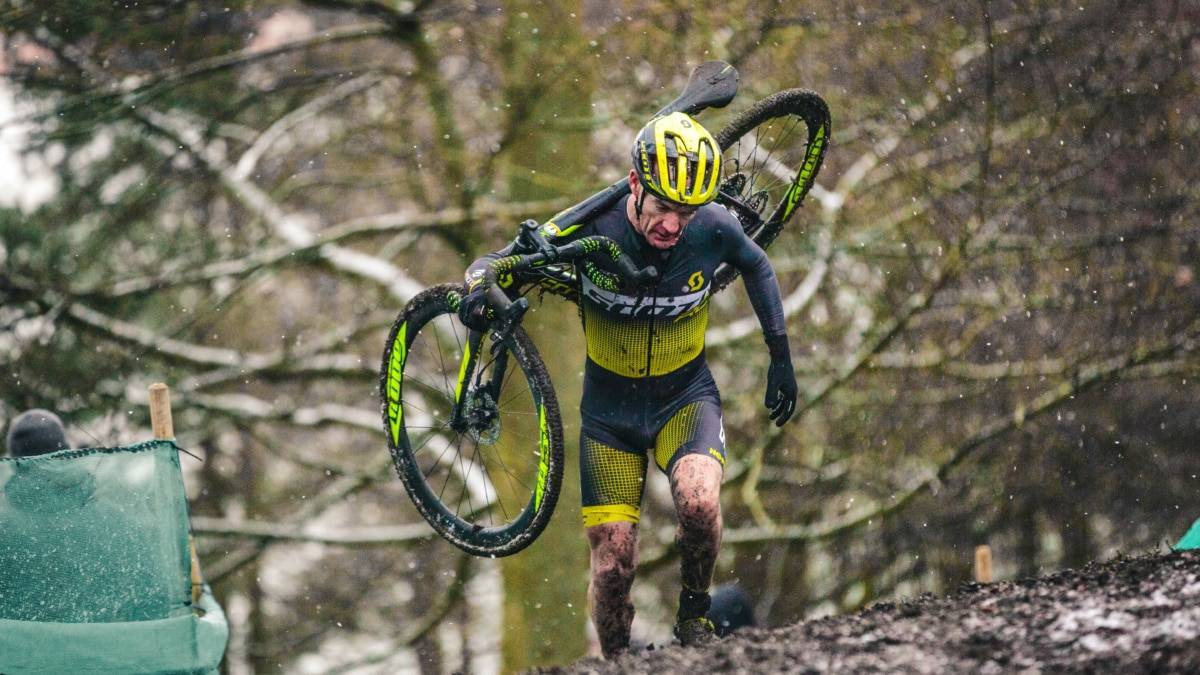
Photo Credit: Unsplash
CYCLOCROSS
Cyclocross is a short, intense form of competitive bike racing that was created to allow road riders to continue racing and remain fit over cold European winters. Commonly referred to as ‘CX’, cyclocross is ridden in all weather conditions, no matter how bad, using bikes that visually resemble road bikes, but with significant engineering modifications to allow for much rougher terrain. It’s common to see races conducted over snow, dirt and sand, as well as a myriad of obstacles – natural or man-made – including jumps, stairs, mud bogs, creeks, rocks and incredibly steep hills. Getting off you bike and carrying it for the bigger, non-rideable challenges, is all part and parcel of CX, with mud-spattered riders the norm.
Cyclocross is often conducted on circuits of 2.5km-3.5km length with a strong focus on spectators being able to see a lot of the action.
Cyclocross bikes have the most in common with modern gravel grind bikes (although the former is the genesis competitive format, the latter a recent cycling phenomenon), but there are some subtle differences. Cyclocross bikes are more aggressive in their engineering in order to be able to withstand a serious belting more in the realm expected in traditional mountain bike formats. The main differences in design geometry (from road or gravel bikes) are the headtube angle and bottom bracket height. The slacker head tube angle provides riders with greater control on descents and at lower speeds, the latter a strong characteristic of cyclocross, being it is taking place on undulating, rough, twisty and obstacle-strewn looped courses. Therefore, control at low speed is crucial. The raised bottom bracket area helps riders with clear obstacles easier and pedal more efficiently through corners. The higher bracket does raise a rider’s centre of gravity, making handling touchier, so many riders will lower seat height so to counter the change.
Both gravel and cyclocross bikes have large tyres. For competitive Cyclocross (given it was borne in the heat of competition) UCI regulations (the sport’s governing body), limit true Cyclocross bike tyre width to 33mm. In contrast, gravel bike tyres can be much larger.
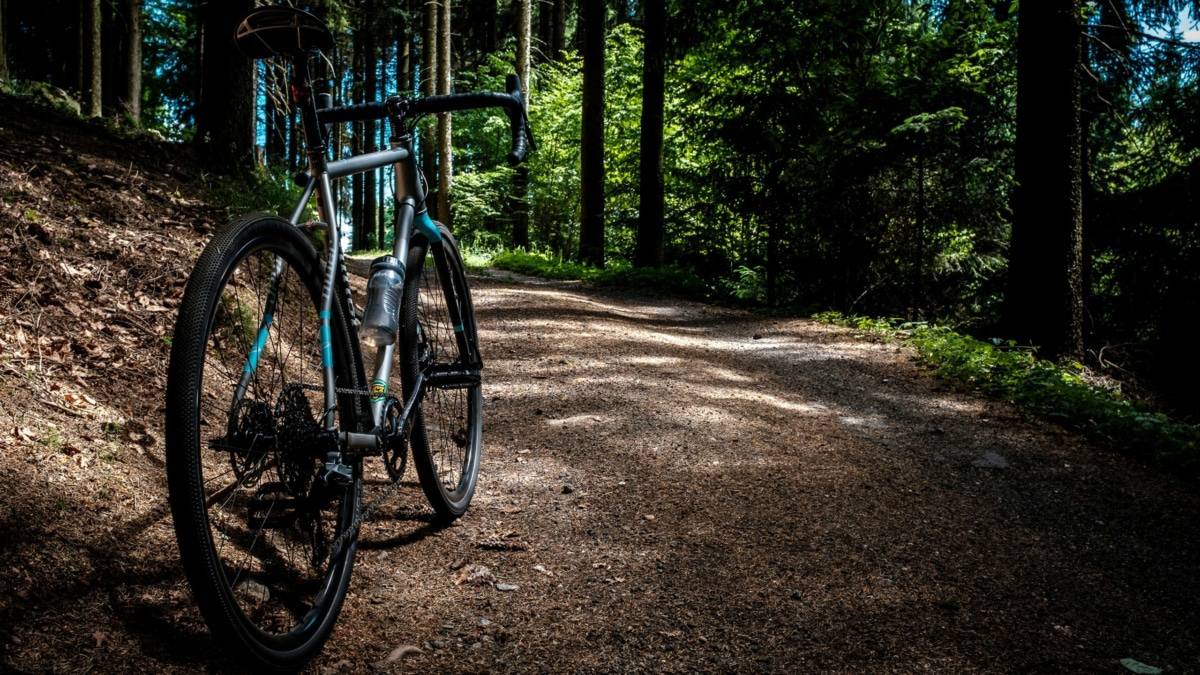
Photo Credit: Unsplash
GRAVEL GRIND
Gravel Grinding is the love child of road and mountain biking. It could be argued its DNA is slightly skewed toward road cycling in that it takes place mostly (but not exclusively) on dirt roads rather than singletrack and bikes are engineered similar to, but modified, from road bikes. (these bikes are basically 1990s XC bikes with drop bars IMHO – marketing genius!!!) The term gravel grind encompasses a fairly broad sweep of riding activity but pertains mainly to long distance day rides – most often 100km+ – that seek out back country, dirt and fire track roads with little to no traffic. Gravel Grinders will often want to sniff out impressive ascent profiles on their routes and as such are likely well acquainted with Strava and competitive bets with friends. Gravel Grind events – both competitive races and non-competitive challenges – are a rising phenomenon across the world, but particularly in North America and Australia where the countryside is vast and fairly unpopulated and landscapes attractive to ride through.
Gravel Grind bikes are versatile, adaptable and durable, with a focus on greater comfort for longer-form adventures and the types of rough, remote road routes and variable surfaces that comes with rural landscapes. With elements derived from road, mountain and cyclocross bikes, gravel bikes are designed to be extremely durable and robust, along with having an increased gear range and space for far wider tyres. Gravel bikes are capable enough to be ridden by skilled riders on easier singletrack trails. A long wheelbase delivers stability on loose surfaces and over long distances. Positioning of a tall headtube combined with a shorter top tube has the rider in a more upright position for improved comfort on touring adventures and better vision. The headtube angle is ‘slack’ to deliver better slow-speed performance and less twitchy response than high end road bikes.
The frame is more substantial than a road bike to enhance durability and, as gravel grind can sometimes merge into backcountry touring, it is usually rigged to enable extra loads carried in frame bags. Gravel bikes use large tyres over 35mm, and often up to 50mm to improve comfort, grip, and stability. Frames have considerable clearance to accommodate the bigger wheel and tyre combinations and disc brakes remove the need for rim-brake callipers, creating increased tyre clearance. They also provide better control and performance in wet weather conditions.
In the early days, Gravel Grind riding and adventure biking were lumped under the same umbrella, however it is arguable that Gravel Grind has intensified its focus over recent years to be primarily day outings (as opposed to multiday), and more competitive or challenge-focused.
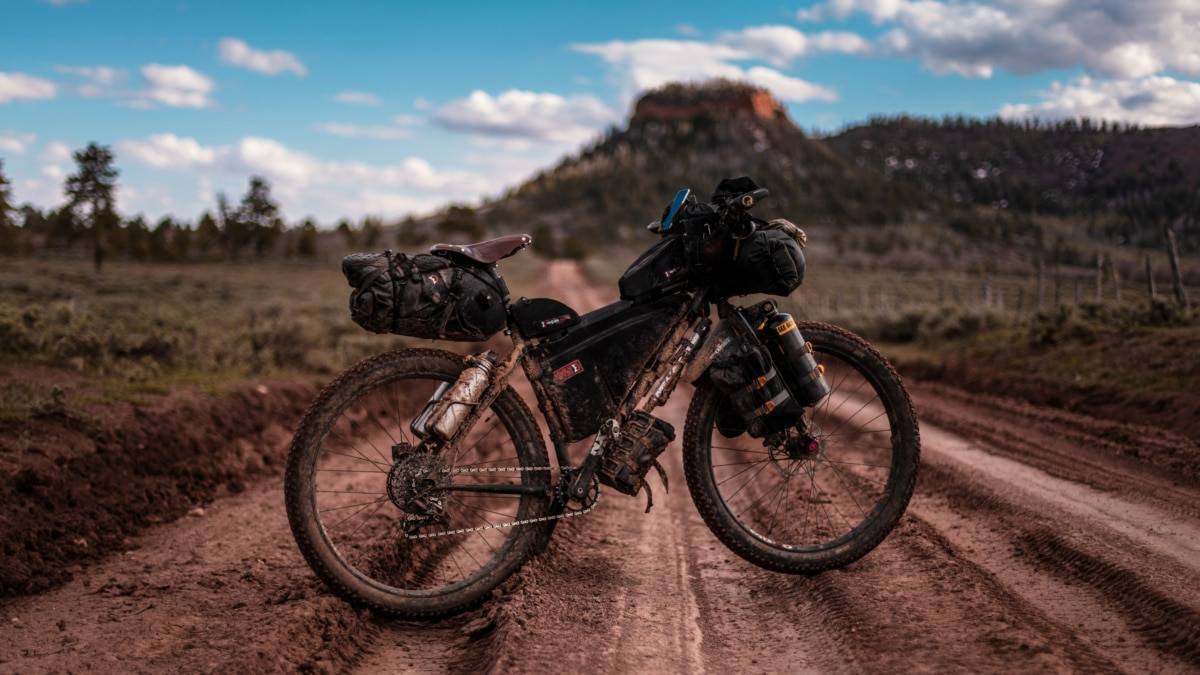
Photo Credit: Unsplash
BACK COUNTRY TOURING / BIKE PACKING
Bikepacking is the birthchild of mountain biking and backpacking. It delivers the adventurous freedom of multi-day backcountry hiking, combined with the range and added thrills of riding a mountain bike. It’s about exploring remote places via singletrack trails, gravel, and abandoned dirt roads, carrying only essential gear.
While Backcountry Touring can be done on gravel grind bikes, it is more often undertaken on a mountain bike, which delivers better capacity for loading up with luggage while maintaining better stability – important when your load is heavy and you are rolling over rough ground. Because mountain bikes tend to move more slowly than road bikes, and carrying loads tend to be much more than on Gravel Grind adventures, daily distances tend to be shorter for backcountry rides, favouring roughly the 60km mark and often entailing lots of stopping en route to admire vistas, or stop at the country bakery. More determined riders can, however, surpass 100km in a day, depending on terrain, climbing profile of the route, luggage load, weather and sunlight hours.
Where Gravel Grinding is usually (but not always) a single day outing and orientated towards competitive or challenge-related goals, Bikepacking is all about slow travel exploration. It is based around multiday, often multi-week and sometimes multi-month journeys where the focus is on exploration of places, landscapes, towns and tourist attractions: simply, it is having a grand adventure on two wheels while being mostly self-sufficient. ‘Mosty’ because while hardcore riders take pride in being an island unto themselves in terms of sufficiency, the profile of Bikepacking has softened somewhat with riders now often staying at B&Bs, hotels, motels and caravan parks and eating out at cafes and restaurants.
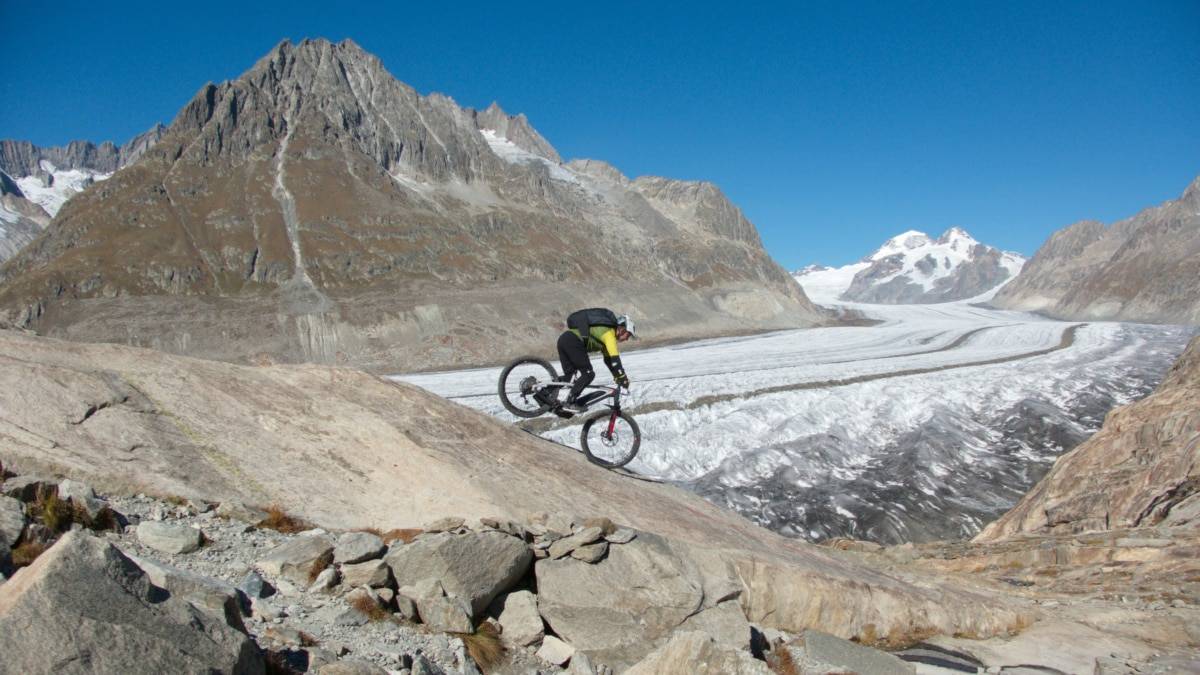
Photo Credit: Unsplash
ADVENTURE RIDING
Adventure Riding can be a term used for Gravel Grinding and/or Bikepacking. Both are, after all, adventurous. But to be pernickety, there is a case for Adventure Riding to be described as its own category. It is more closely aligned specifically to mountain biking and somewhat to Bikepacking, where the definitive characteristic is taking your mountain bike well off road, into the remote wilderness and often on mountainous singletrack trails on a mission to get from point to point through terrain that would not usually be considered ideal cycling territory. Bikes are tough and generally the style of steed is swiped from something akin to All Mountain or XC. As with Bikepacking, Adventure Riders are self-sufficient but to a more extreme (and necessarily lightweight) degree as there are no bakeries or Air BnBs in the mountains. Rides will combine lugging gear on their back (not something bikepackers tend to do) and on their bike frame, but to a minimal degree given there is often a degree of pushing and carrying your bike when confronted with unrideable terrain. This is extreme mountain biking where adventure and exploration is taken to its limit on two wheels.
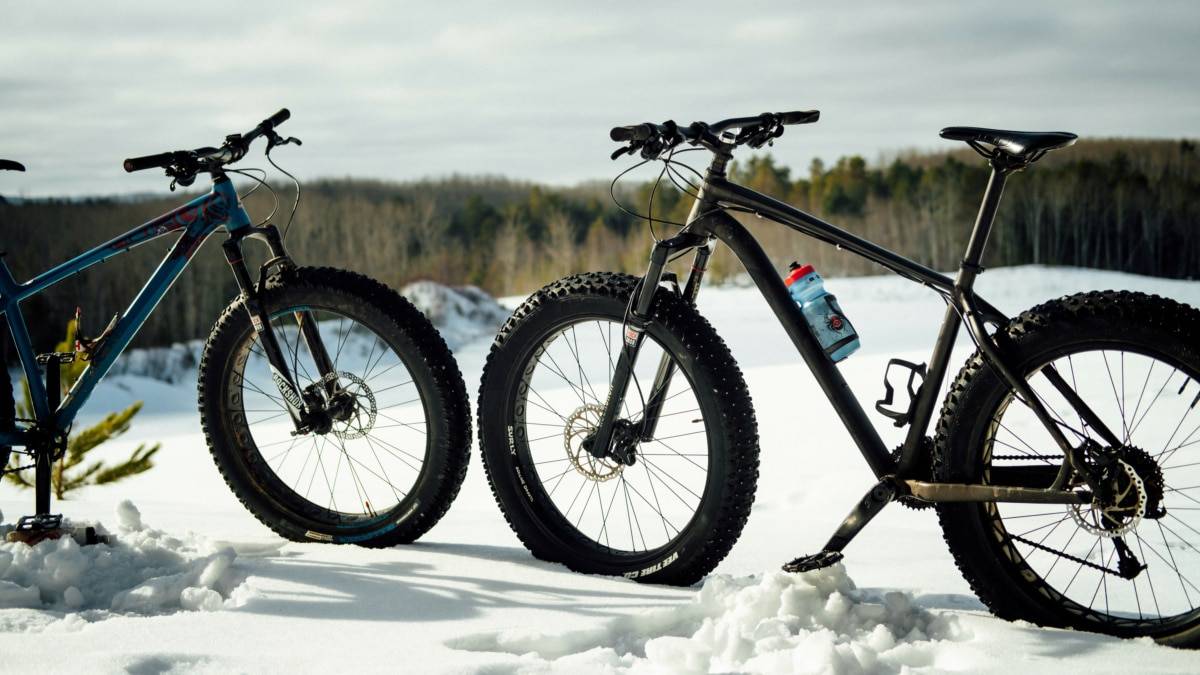
Photo Credit: Unsplash
FATBIKING
Fatbikes are perhaps one of the smallest niches in mountain biking. They use oversized tyres that are around 97mm thick to help ride on difficult surfaces such as sand, snow or mud. Bigger tyres ‘float’ on such ‘sinky’ terrain, providing good traction. They open up riding on often trail-less terrain traditionally not thought of great for bikes. Of course, just as serious mountain down jackets are seen on the high street, so, too, are we now seeing Fat Bikes ridden around town for kicks. While this is not what they are made for, Fat Bikes are easy to ride and popular because the low-pressure wheels provide extra suspension giving a cushy ride. Fatbikes can get you out on snow covered trails, beaches, deserts and they make riding uphill in thick mud much easier.
There are also specific extreme events that require Fatbike set-ups including racing in places like Alaska and the Simpson Desert.
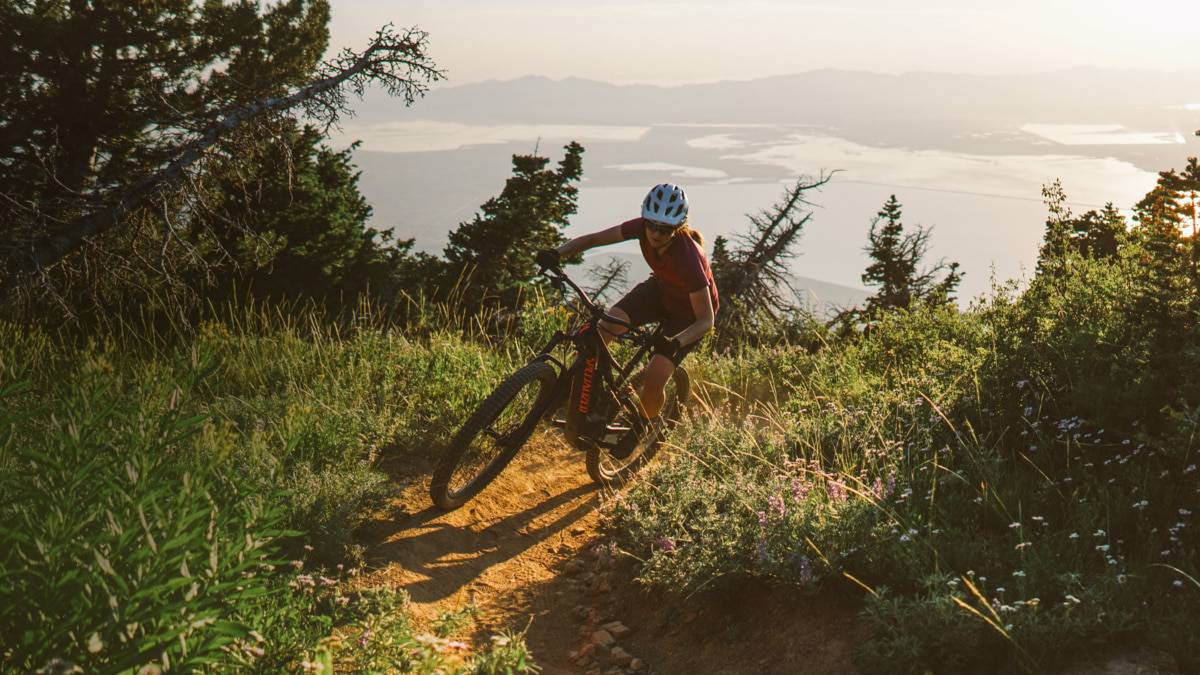
Photo Credit: Specialized
E-MTB
E-MTB is less a style and more a form of bike technology. Battery-powered, rechargeable bikes deliver power through the pedal crank (not directly to the wheels) to help a rider – who still needs to pedal –move over terrain with less effort, most beneficially on the uphill. This means e-bikes are mostly prevalent within disciplines where climbing is part and parcel, such as XC, All Mountain and sometimes Flow.
E-MTBs have been gaining serious traction in the mountain biking world and have been credited with a second wave in popularity of mountain biking as riders are reinvigorated to get back on trails without worrying about fitness levels or their capacity for uphill efforts.
E-bike riders typically seek a recreational experience, more so than a competitive one, valuing high-quality, accessible, nature-based experiences that offer some degree of support (via township and service integrations, inclusive charging points for longer distance journeys).
E-MTB bikes feature different assistance levels or modes, ranging from low-output, aiding in slightly undulating sections, to punchy high-output modes that help riders climb with ease (but at a cost of battery life and distance range). There is no typical range for an E-MTB as battery life depends on all of rider weight, terrain and technicality of the ride, ascent profile, battery size and quality, componentry and tyres, and how a rider engages assist modes throughout the course of a ride. However, a moderately hilly ride on a quality bike with conservative use of the power will get you between 40-50km.
E-MTB’s are typically outfitted with specific componentry that addresses the heavier weight and bigger forces exerted on it, with high-stress components such as the chain, cassette, crankset, rims and hydraulic disc braking system all reinforced to deal with additional braking forces.
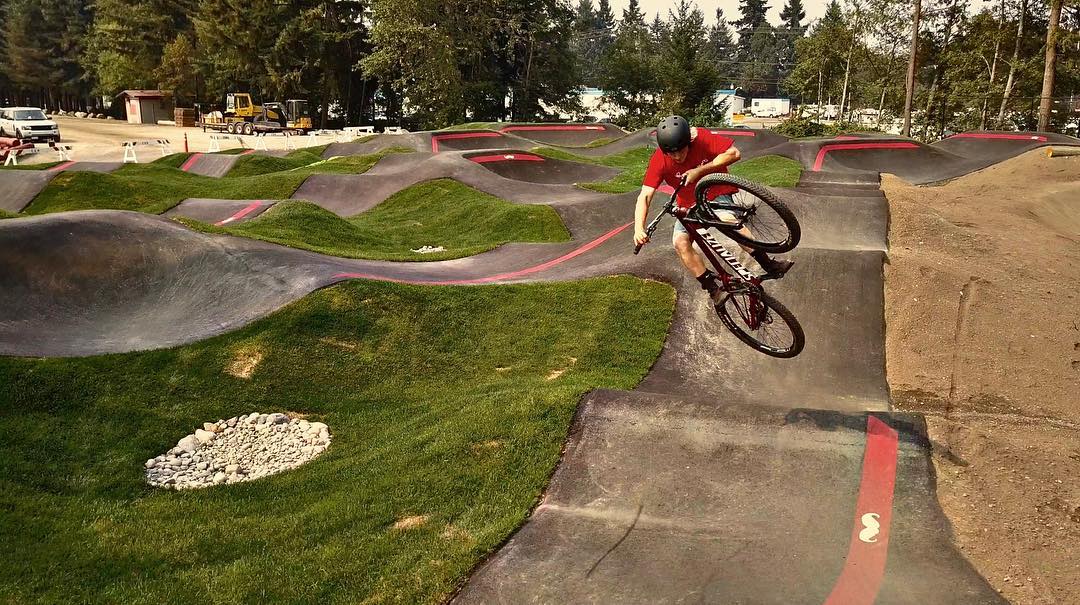
Photo Credit: Velosolutions
PUMP TRACKS
Pump tracks are highly specific continuous circuit tracks designed to ‘pump’ your bike around them, rather than pedal, an action where the quick downhills of a roller feature or angle and placement of a berm are designed so specifically that you can use momentum and weight, to roll around the entire course. It is a skill of timing, body position and movement, which means pump tracks are also great for honing general bike skills.
Pump track features are all variables of rollable mounds, so all courses are beginner-friendly, with riders of all abilities able to safely navigate them and have fun, be that fast fun (better for the ‘pump and jump’) or slower paced froth. As riders improve bike control, they are able to generate more momentum and flow, build confidence and eventually – on bigger courses – start incorporating jumps as they launch off some features like table-tops. There is arguably some crossover between 4X and pump tracks where the course and features are bigger, however not all 4X tracks are 100% no-pedal ‘pump-able’. Pure pump tracks should require no pedalling by those with some level of skill.
Smaller pump tracks can be professionally made of timber (plywood – often transportable and used for events), concrete or surfaced with bitumen, although there are plenty of community and amatuer-built dirt pump tracks. They are often placed within easy access of communities or at trail heads, but given their small footprint, pump tracks are popular features for people to build themselves in backyards and private paddocks. Pump tracks – especially low maintenance, low-footprint styles made accessible within population centres – are credited as focal points for encouraging community spirit, bike skills progression and active outdoor lifestyles.
Pump tracks were no doubt seeded by BMX track design (although pedalling is required for BMX) and some pundits credit the first pump tracks to have appeared in Australia, apparently as self-made fun parks for DH racers.
Smaller pump track design has also made the crossover to other recreational scenes with courses created specifically for skateboards, scooters and wheelchairs.
There now exists a pump track championships managed by Red Bull with 23 groundbreaking events first taking place around the world in 2018. More than 2,000 athletes participated in over 19 countries and 67 riders competed in the first World Final that saw local riders compete against Olympic BMX racers and MTB World Champions.
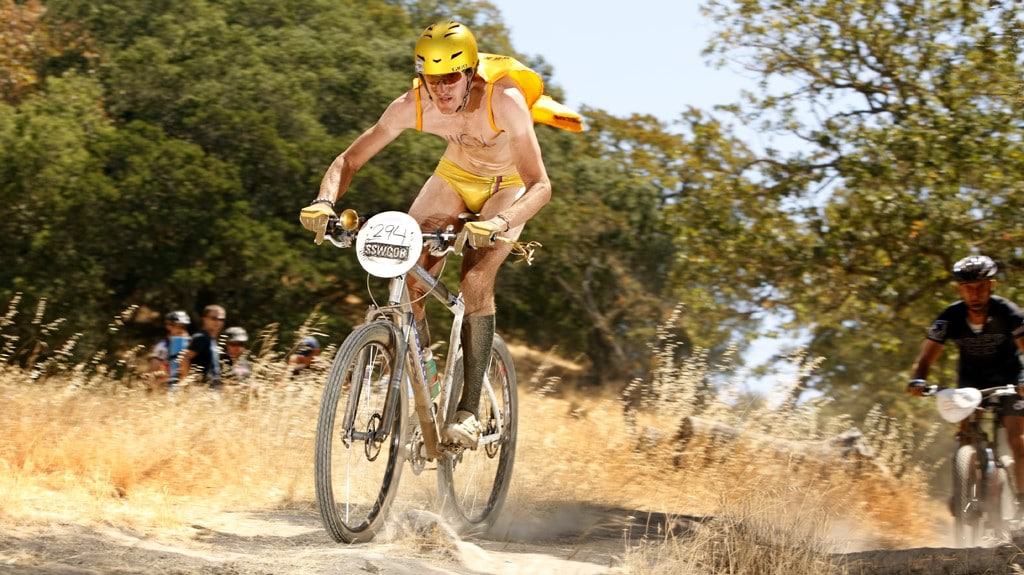
Photo Credit: Singlespeed World Championships reviews.mtbr.com
SINGLESPEED MTB
One of the things that made mountains accessible to riders is gears. Cogs of different sizes front and back and the rules of ratios meant riding uphill was made if not easy at least more achievable. More recently, e-bikes have magnified tenfold the ease of climbing. Equally, harder gears meant whistling downhills could be accelerated even more. Basically, gears were a gift from the mountain biking gods. Singlespeed mountain biking is the exact opposite end of the suffering spectrum – some may say the devil’s response. Take away the ability to choose a perfect gear according to your terrain. One gear. Uphill, downhill, technical feature to navigate, mud patch to get through – doesn’t matter. No choice. Just pedal. Hard. Harder. Harder still. Nice thighs, though.
Singlespeeders are the freaks of mountain biking (and that is written with absolute and due respect), because they pedal and work harder than anyone else on trail. Everything is more difficult.
Singlespeed bikes are about simplicity with a rigid frame, sometimes a rigid fork, too…and no gears. It’s certainly for purists if not puritans who don’t want the fuss and bother of all the technology that makes life riding mountains more comfortable. But masochism is a thing of pleasure to some and indeed, the annual Aussie champs are massive boost to local economies such is attendance, and the World Champs is even bigger.
One argument for singlespeed style in mountain biking is that it can improve technique. Singlespeed riding in hilly terrain places a focus on maintaining momentum with more consistency to be able to attack the hills with more likelihood of success and less of exhaustion. Singlespeed mountain bikes also encourage you to carry greater speed through corners or over obstacles. As a result, riding becomes smoother and more efficient.
Singlespeeders are both competitive and recreational but are always about the challenge – so they tend to ride harder routes with plenty of climbing. There is a strong community culture amongst the singlespeed brigade – they are the baristas of the cycling world, all manicured beards (well, for the blokes), tattoos, styled and dialled-in fashion, good coffee and micro-brew beers. The latter seems to be as important as the single gear set up. There’s also a healthy sense of the absurd with singlespeed culture embracing fun and frivolity at all times (witness the dress up at events – yes, even at World Championship events). So, singlespeed upsides: great parties and even better quads.


